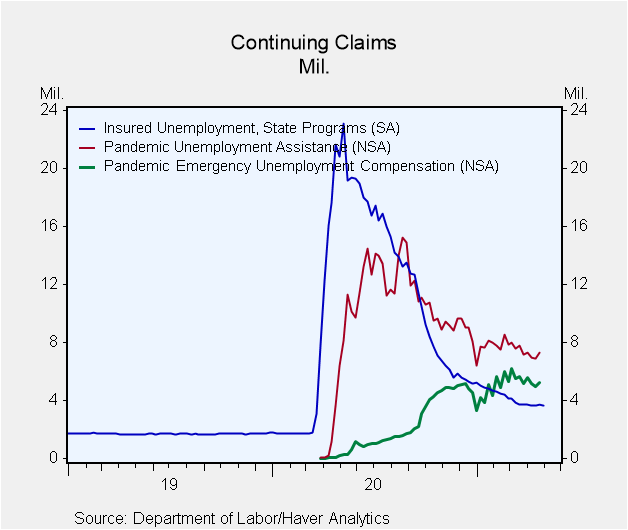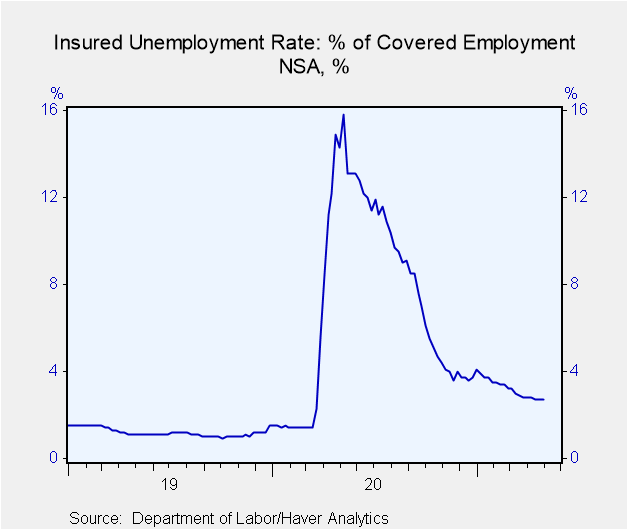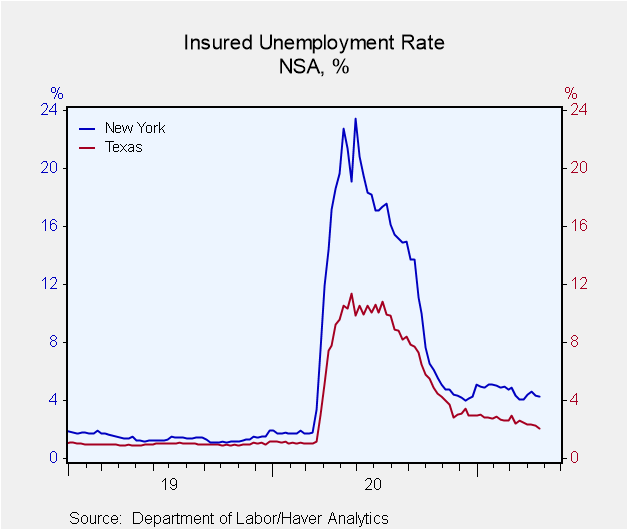 Global| May 13 2020
Global| May 13 2020U.S. Initial Unemployment Claims Continue to Fall
by:Sandy Batten
|in:Economy in Brief
Summary
• Initial claims fall to another pandemic low. • State continuing claims and insured unemployment rate edged down. • PUA and PEUC continuing claims rose. Initial claims for unemployment insurance declined to 473,000 in the week ended [...]
• Initial claims fall to another pandemic low.
• State continuing claims and insured unemployment rate edged down.
• PUA and PEUC continuing claims rose.
Initial claims for unemployment insurance declined to 473,000 in the week ended May 8 from an upwardly revised 507,000 in the previous week (initially 498,000). The Action Economics Forecast Survey panel expected 500,000 new claims. The latest week's figure represents a new low since the start of the pandemic in March 2020, but it remains well above pre-pandemic levels. The 4-week moving average fell to 534,000 in the week ended May 8, also a pandemic low, from 562,250 in the previous week.
Initial claims for the federal Pandemic Unemployment Assistance (PUA) program rose to 103,571 in the week ended May 8 from a slightly upwardly revised 101,815 (initially 101,214) in the previous week. The PUA program provides benefits to individuals, such as the self-employed, who are not eligible for normal state unemployment insurance benefits. Given the brief history of this program, these and other COVID-related series are not seasonally adjusted.
Continuing claims for regular state unemployment insurance slipped to 3.655 million in the week ended May 1 from 3.700 million the previous week. The state insured rate of unemployment edged down to 2.6% in the week ended May 1 from 2.7% the previous week, the lowest level since the pandemic started. It reached 15.9% in May 2020.
Continuing PUA rose in the week ended April 24, the first increase in three weeks, to 7.284 million from 6.863 million in the prior week. Also in the April 24 week, the number receiving Pandemic Emergency Unemployment Compensation (PEUC) increased to 5.265 million from 4.973 million, which was the lowest level since the second week of February. This program covers people who have exhausted their state benefits.
The total number of all state, federal, and PUA and PEUC continuing claims rose 696,152 to 16,855,264 in the week ended April 24. This compares with a total of 21,863,056 in the comparable week in 2020. This grand total is not seasonally adjusted.
The state insured rates of unemployment continued to vary widely. In the week ending April 24, the highest insured unemployment rates were in Nevada (6.41%), Connecticut (4.89%), Rhode Island (4.61%), Alaska (4.51%) and Vermont (4.47%). The lowest rates were in Kansas (0.65%), South Dakota (0.79%), Nebraska (0.90%), Utah (0.93%) and Alabama (0.97%). Insured unemployment rates in other large states included New York (4.24%), California (3.54%), Texas (2.09%) and Florida (1.51%). These state rates are not seasonally adjusted.
Data on weekly unemployment claims going back to 1967 are contained in Haver's WEEKLY database, and they are summarized monthly in USECON. Data for individual states are in REGIONW. The expectations figure is from the Action Economics Forecast Survey, carried in the AS1REPNA database.
| Unemployment Insurance (SA, 000s) | 05/08/21 | 05/01/21 | 04/24/21 | Y/Y % | 2020 | 2019 | 2018 |
|---|---|---|---|---|---|---|---|
| Initial Claims | 473 | 507 | 590 | -79.6 | 1352 | 218 | 220 |
| Initial Claims (NSA) | 487 | 514 | 612 | -79.1 | 1,353 | 218 | 221 |
| Initial Claims Pandemic Unemployment Assistance (NSA) | 104 | 102 | 121 | -88.4 | -- | -- | -- |
| Continuing Claims | -- | 3,655 | 3,700 | -82.4 | 10,380 | 1,699 | 1,754 |
| Continuing Claims (NSA) | -- | 3,710 | 3,796 | -82.2 | 10,370 | 1,704 | 1,763 |
| Continuing Claims Pandemic Unemployment Assistance (NSA) | -- | -- | 7,284 | -- | -- | -- | -- |
| Insured Unemployment Rate (%) | -- | 2.6 | 2.7 |
13.9 |
7.1 | 1.2 | 1.2 |
Sandy Batten
AuthorMore in Author Profile »Sandy Batten has more than 30 years of experience analyzing industrial economies and financial markets and a wide range of experience across the financial services sector, government, and academia. Before joining Haver Analytics, Sandy was a Vice President and Senior Economist at Citibank; Senior Credit Market Analyst at CDC Investment Management, Managing Director at Bear Stearns, and Executive Director at JPMorgan. In 2008, Sandy was named the most accurate US forecaster by the National Association for Business Economics. He is a member of the New York Forecasters Club, NABE, and the American Economic Association. Prior to his time in the financial services sector, Sandy was a Research Officer at the Federal Reserve Bank of St. Louis, Senior Staff Economist on the President’s Council of Economic Advisors, Deputy Assistant Secretary for Economic Policy at the US Treasury, and Economist at the International Monetary Fund. Sandy has taught economics at St. Louis University, Denison University, and Muskingun College. He has published numerous peer-reviewed articles in a wide range of academic publications. He has a B.A. in economics from the University of Richmond and a M.A. and Ph.D. in economics from The Ohio State University.










